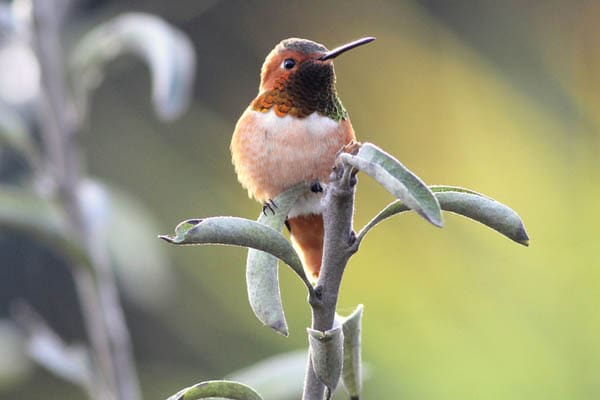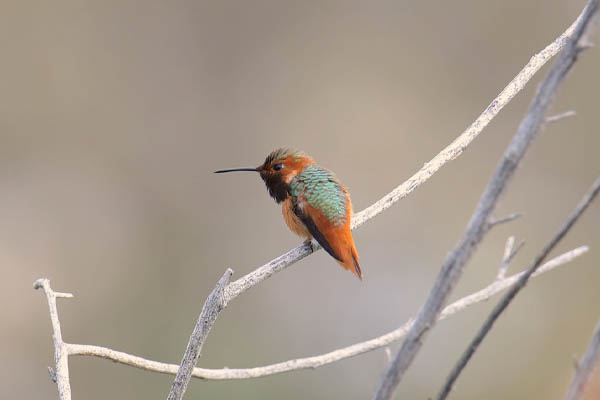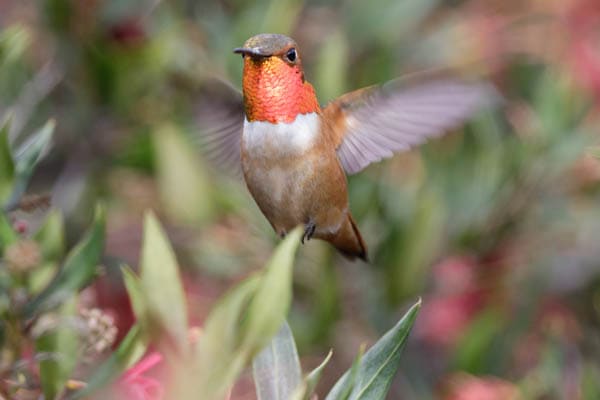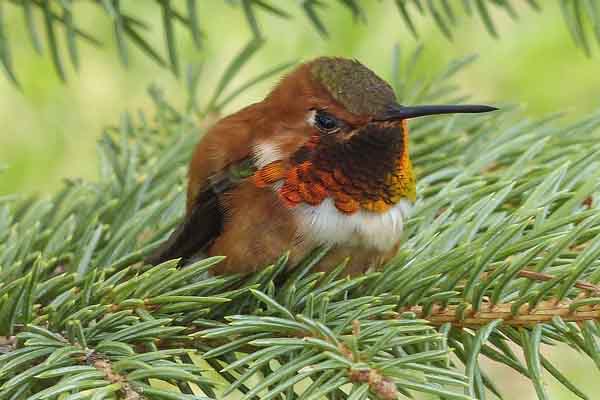Contents
- Allen’s hummingbird facts
- How to Identify an Allen’s hummingbird
- Where you’ll see Allen’s hummingbirds
- Diet & Feeding Preferences of the Allen’s hummingbird
- Allen’s hummingbird nesting
- Allen’s hummingbird behavior
- Conservation Status of the Allen’s hummingbird
- Fun & Interesting Facts about the Allen’s hummingbird
- Explore More Species in This Family
Allen’s hummingbird is a colorful diminutive bird that goes by the scientific name Selasphorus sasin. This tiny bird is a North American native primarily found along the western coastal regions. In fact, the American ornithologist Charles Andrew Allen was a collector of small birds and animals, so this hummingbird was named after him.
What makes Allen’s Hummingbird stand out? Most specifically, this bird is known for its distinctive courtship displays and its vibrant plumage. Primarily, you’ll see this bird along the Pacific coast, beginning in southern Oregon and moving all the way to Baja California and Mexico. It’s also a migratory bird, so it spends its breeding season in the coastal California regions but loves to spend its winter in Mexico.
Birdwatchers and nature enthusiasts are captivated by Allen’s hummingbird because of its acrobatic flight, its charming courtship displays, its stunning appearance, and much more. This beautiful avian species is a cherished creature living on the North American West Coast.
Today, I’d like to tell you more about other crucial topics regarding Allen’s Hummingbird. The areas that we’ll cover in greater detail below include:
- Specific traits and physical descriptions of Allen’s Hummingbird
- The overall differences between male and female Allen’s hummingbirds
- Nesting habits, feeding preferences, migration patterns, and dietary choices of Allen’s hummingbirds
- Even more critical information regarding Allen’s hummingbirds
Are you excited to discover the truth about Allen’s hummingbirds? Continue reading below to learn everything you ever needed to know about these exciting and fast-moving birds.

Allen’s hummingbird facts
Common Name: Allen’s Hummingbird
Scientific Name: Selasphorus sasin
Scientific Family: Trochilidae
Life Span: 4-10 years
Size: 3.5 to 4.0 inches
Wingspan: 4.0 to 4.5 inches
Weight: 0.10 to 0.20 oz
Conservation status: Least Concern
How to Identify an Allen’s hummingbird
There are a number of different ways to properly identify Allen’s Hummingbird, also known as Selasphorus sasin. Yet, these birds are very similar to many other Hummingbird species, but in particular, it looks a lot like the Rufous Hummingbird. Nevertheless, there are certain key behaviors and features that you can focus on to distinguish an Allen’s Hummingbird properly. They include:
- Size and Shape – Allen’s hummingbird is definitely on the small side as far as hummingbirds are concerned since it only measures 3.5 to 4 inches in length. Its body is stocky, compact, and it has a relatively short bill as well.
- Plumage – Allen’s hummingbird plumage for adult males differs from females. This bird’s throat or gorget is a vibrant orange-red, but at other times it may appear fiery red, coppery, or Golden, depending on the lighting conditions. It has an iridescent green back, while its chest and belly are white. Females, on the other hand, have similar coloring, but their tones are much duller, and they do not have the flashy gorget either.
- Tail Feathers – Allen’s hummingbird has outer tail feathers that have a green and rufous color. While flying, the colors appear to show us a flash of rufous coloring. Yet, this distinction makes it easy to differentiate rufous hummingbirds from Allen’s hummingbirds because the green coloration is mixed in.
- Vocalizations – the vocalizations of the Allen’s Hummingbird are heard mostly during territorial disputes and courtship displays. They will emit high-pitch vocalizations in these situations. While flying, these birds emit sharp buzzing and chirping notes and sounds.
Difference between Male & Female Allen’s hummingbirds
Male and female Allen’s hummingbirds are very similar but they do possess distinct differences as well. Females do not have the flashy orange-red gorget that also omits shades of fiery red, copper, or gold and shimmers in appearance.
As far as size is concerned, they are both relatively the same size and typically range between 3.5-4 inches in length. The male’s back and crown is usually green, and the belly and chest area are white. For females, they have the same or similar plumage colors except they do not have a vibrant throat, because they are either pale gray or whitish in color with faint streaking.
Differences in Summer Plumage vs Winter Plumage
Male and female Allen’s hummingbirds will undergo a mold during the winter. What does this mean for their appearance? It means that both of their appearances become less vibrant during the winter months when compared to the summer breeding season. Yet, the males look even duller than the females because female plumage is relatively dull all year round.
Where you’ll see Allen’s hummingbirds

Allen’s hummingbirds love occupying a variety of habitats that are primarily found along North America’s West Coast. In particular, the habitats that they tend to gravitate toward include urban areas, parks, gardens, open woodlands, chaparral, and coastal scrub.
More specifically, the areas you’re likely to see Allen’s hummingbirds include:
- Coastal California – Allen’s Hummingbird is commonly seen along the coastal areas of California. Their most likely to be found along California’s central coast all the way down to Baja California and Mexico. Protect more specifically, they are seen in San Diego, Santa Barbara, Big Sur, Los Angeles, and Monterey.
- Oregon – these birds are also living in parts of southern Oregon, also along the coast. They like to come here during the breeding season more than any other season.
- Baja California in Mexico – you can find Allen’s hummingbirds along the coastal regions of Baja California in Mexico. Their area extends southward from the California border.
Allen’s hummingbird migration patterns
It’s important to know that Allen’s hummingbirds are also migratory birds. They will spend their winters in Mexico and return to the Pacific coast to revisit their favorite breeding grounds during spring and summer.
So, this means the presence of Allen’s hummingbirds will vary during different parts of the year. Most specifically, you can find them along the California coast and Oregon during their breeding season.
Diet & Feeding Preferences of the Allen’s hummingbird
As far as their diet is concerned, Allen’s Hummingbird is mostly known for drinking nectar and eating small insects as well as fighters. Some of their feeding preferences include:
- Nectar – the sugary sweet nectar as their favored nutrition source and they were designed to drink it. They have a long and slender bill that is specifically adapted for probing deeply into flowers, which makes it easy for them to access the nectar. They love visiting a wide range of flowering plants throughout the day to get their nectar. Some of their favorite plants include fuchsia, salvia, paintbrush, red columbine, red monkey flower, the yellow blooms of tree tobacco, red paintbrush flowers, and other red tubular flowers.
- Small Insects and Spiders – insects and small spiders are another way for them to supplement their diet and get lots of nutrients and especially protein. In particular, they tend to gravitate toward tiny anthropologists and spiders, mosquitoes, gnats, and small flies, which they will grab by the wing and pluck them off of spiderwebs.
- Hummingbird Feeders – this bird has no problem visiting hummingbird feeders as long as they are filled with sugary nectar-like solutions. The solution should contain four parts water to one part granulated white sugar for those looking to attract Allen’s Hummingbird and other hummingbirds to their backyard.

Allen’s hummingbird nesting
- Clutch Size: 1-3 eggs
- # of Broods: 2-3 broods
- Incubation Period: 12-14 days
- Nestling period: 18-22 days
- Egg Description: White with gray and brown spots
The nesting habits of Allen’s hummingbirds is definitely interesting to say the least.
Nest construction falls upon the female’s shoulders, or wings as it were! She is responsible for building their cup-shaped nest that is typically 1.5-2 inches in diameter. The material she’ll use include spiderwebs, downy material from sunflowers and willows, lichen, moss, and plant fibers. She also camouflages the outside of the nest with tree bark so it blends into the environment.
When building the nest, Allen’s Hummingbird will typically do so on horizontal branches of shrubs or trees. In other cases, they may even use man-made objects including clotheslines, hanging baskets, light fixtures, and wires. Typically, they will conceal the nest in dense foliage or thick vegetation to keep it sheltered and protected from predators.
The average clutch size of an Allen’s Hummingbird brood is usually two eggs. The female will incubate her eggs and keep them warm for approximately 12-14 days. Once the eggs are hatched, she will care for the nestlings for 18-22 days, in which the female will feed the young birds by sharing regurgitated small insects and nectar with them.
Remember, Allen’s hummingbirds will actually raise more than one brood each year. On average, they’ll raise two broods, and occasionally they’ll even raise a third. This depends on the length of the breeding season and resource availability.
Allen’s hummingbird behavior
Allen’s hummingbirds have unique and distinctive behavior that are characteristic to these diminutive birds. The most notable behaviors that we haven’t already described in detail include:
- Aggression and Territory Defense – the male member of the Allen’s Hummingbird species possesses territorial behavior and he’s quite aggressive and fights when defending its territory. While the breeding season is underway, males will establish their territory and defend it aggressively. Their territories are usually centered around their nesting site and reliable food sources. They defend their territories vigorously from other males and will engage with them aggressively by performing aggressive aerial chases, high-speed dive displays, and aggressive dominance-establishing vocalizations.
- Courtship Displays – like many male hummingbirds, the male members of Allen’s Hummingbird species love performing elaborate courtship displays in an effort to attract females during the breeding season. Their displays are quite impressive and consist of magnificent flights, rapid wing beats, and aerial acrobatics known to catch a female’s eye. They also love showing off their vibrant gorget to get a female’s attention. They even make certain vocalizations during courtship while wooing the female members of their species.
- High Metabolic Rate and Resting Behavior – the metabolic rate of Allen’s Hummingbird is exceptionally high. It needs to be in an effort to support their hovering flight and incredibly quick wing beats. Their need for energy is in high demand and requires consuming large amounts of nectar and insects to meet their fuel needs so they can continue their active lifestyle. They can also enter a state of torpor that allows them to conserve energy by lowering their metabolic activity. This typically happens at night or during times when food is scarce.
Conservation Status of the Allen’s hummingbird
According to the International Union for Conservation of Nature, also known as IUCN, the Allen’s Hummingbird is assessed as Least Concern. This means that the population of Allen’s Hummingbird and rufous hummingbirds, which are very similar, is stable and not currently facing any major or significant threats, population decline, or nearing extinction.
Fun & Interesting Facts about the Allen’s hummingbird
- One fun fact is that it’s very difficult to distinguish between female Allen’s hummingbirds and female rufous hummingbirds because they are so similar in nature. If you carefully observe each bird, you’ll notice different tail patterns and vocalizations, which are important distinctions needed to properly identify each bird.
- The wing beats of the Allen’s Hummingbird are incredibly quick. In fact, they are capable of beating their wings 70 times per second while flying normally. During courtship displays, they are known for beating their wings even faster. In some cases, they may beat their wings up to 200 times per minute, which is lightning fast. Their quick wing beats makes it possible to fly backwards, hover, and employ impressive aerial maneuvers.
- Hovering efficiency is the name of the game when it comes to Allen’s hummingbirds. Their hovering abilities are second to none. They can successfully hover in mid-air and do so stably even when strong winds are gusting. They have specialized wing muscles that allow them to make rapid movements. This is absolutely necessary to their survival because they need this capability in order to feed on nectar found in their favorite red tubular flowers.
- Allen’s Hummingbird eggs are incredibly tiny. Out of all bird species, their eggs are some of the smallest. They are about the size of a jellybean which typically measures 0.5 inches in length, or 1.3 cm. Even though their eggs are very small, they still contain everything needed for healthy Allen’s hummingbirds to develop into healthy nestlings.
- Allen’s hummingbirds are vital members of the ecosystem and they play an important role in the pollination process of flowers. While sucking on nectar from their favorite flowers, they often transfer pollen from one flower to another as they move along amongst different flowering food sources. This helps to facilitate reproduction and fertilization of a number of different plant species.
Explore More Species in This Family
- Snowcap (Microchera albocoronata)
- Blue-throated Hummingbird (Lampornis clemenciae)
- White-tailed Goldenthroat (Polytmus guainumbi)
- Buff-bellied Hummingbird (Amazilia yucatanensis)
- Plain-capped Starthroat (Heliomaster constantii)
- Green-breasted Mango (Anthracothorax prevostii)
- Bronze-tailed Plumeleteer (Chalybura urochrysia)
- Amethyst Woodstar (Calliphlox amethystina)
- Fiery-throated Hummingbird (Panterpe insignis)
- Shining Sunbeam (Aglaeactis cupripennis)
- Brazilian Ruby (Clytolaema rubricauda)
- Violet Sabrewing (Campylopterus hemileucurus)
- Broad-tailed Hummingbird (Selasphorus platycercus)
- Violet-headed Hummingbird (Klais guimeti)
- Ecuadorian Hillstar (Oreotrochilus chimborazo)
- Little Woodstar (Chaetocercus bombus)
- Green Thorntail (Discosura conversii)
- Rufous Hummingbird (Selasphorus rufus)
- Sparkling Violetear (Colibri coruscans)
- Long-billed Hermit (Phaethornis longirostris)
- Anna’s Hummingbird (Calypte anna)
- Calliope Hummingbird (Selasphorus calliope)
- Ruby-throated Hummingbird (Archilochus colubris)
- Crowned Woodnymph (Thalurania colombica)
- Magnificent Hummingbird (Eugenes fulgens)
- Booted Racket-tail (Ocreatus underwoodii)
- White-vented Plumeleteer (Chalybura buffonii)
- Black-chinned Hummingbird (Archilochus alexandri)
- Berylline Hummingbird (Amazilia beryllina)
- Violet-crowned Hummingbird (Amazilia violiceps)
- Black-throated Mango (Anthracothorax nigricollis)
- Black-crested Coquette (Lophornis helenae)
- White-bellied Woodstar (Chaetocercus mulsant)
- Long-tailed Sylph (Aglaiocercus kingii)
- Costa’s Hummingbird (Calypte costae)
- Xantus’s Hummingbird (Hylocharis xantusii)
- White-necked Jacobin (Florisuga mellivora)
- Red-billed Streamertail (Trochilus polytmus)
- Black-breasted Puffleg (Eriocnemis nigrivestis)
- Purple-crowned Fairy (Heliothryx barroti)
- Long-tailed Hummingbird (Rhamphomicron longicauda)
- Gorgeted Woodstar (Chaetocercus heliodor)
- Ruby-topaz Hummingbird (Chrysolampis mosquitus)
- Cinnamon Hummingbird (Amazilia rutila)

